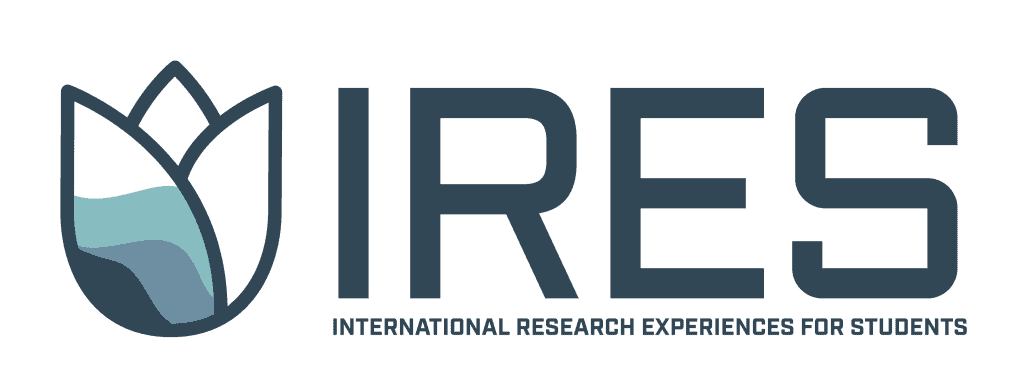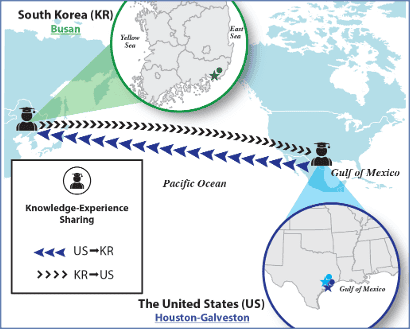
Global Flood Resilience Program in
Busan, South Korea
With new support from the National Science Foundation (NSF), IDRT is launching a new IRES program — the Global Flood Resilience Program (GFRP) — designed to give U.S. students immersive international research experiences focused on flood resilience. Each year, students will either travel to South Korea or collaborate with visiting Korean students in Texas, conducting case study research in a highly interactive, cross-cultural learning environment.
This program expands our global partnerships and allows us to apply and evaluate the flood resilience framework we previously developed with Dutch collaborators, now in new contexts. GFRP not only advances international research but also enables students to address complex, transdisciplinary flood challenges at home and abroad.
SPONSOR: National Science Foundation
PROGRAM DIRECTOR: Yoonjeong Lee
PI: Yoonjeong Lee
CO-PIs: Samuel Brody, Jens Figlus
This program requires an international trip to Korea.
If you are interested in applying for the international research program that does NOT require an international trip, visit the I-REverSe application page. Applicants may apply for both programs, but can only enroll in one if accepted to both.
2026 IRES in South Korea Program Details:
APPLICATION IS OPEN
NSF IRES Global Flood Resilience Program in South Korea – Convergent research experiences to increase resilience in flood-prone communities
International Research Travel Program Application for Field Research in Busan, Korea 2026[1]
The NSF-funded IRES GFRP is pleased to offer funding for students at participating universities — Texas A&M University in College Station, Texas A&M University at Galveston and the University of Puerto Rico at Mayagüez — to travel to South Korea from May 31 to July 11, 2026 to conduct research on flood resilience within a global context*. This research experience involves field trips, lectures, and interactions with international experts and students in Korea.
This opportunity allows both undergraduate and graduate students to enhance and expand their educational and research experience through immersive research activities and interaction with international students and researchers. Participating students can either compare Korea (the Southeastern Coast and Busan metropolitan area) with Texas (the Upper Texas Coast and Houston-Galveston metropolitan area) or investigate the applicability of flood mitigation measures from one place to another.
We encourage students from a wide range of disciplines — including engineering, planning, economics, hydrology, biology, architecture, ecology, geology, computational hydraulics, and more — who are interested in flood resilience and its global dimensions to apply. This program offers a unique opportunity to engage in interdisciplinary research with participants from diverse academic backgrounds and levels, fostering teamwork and leadership skills beyond the classroom.
Applicants may choose one of the focus areas listed below for case study research in the Southeastern Coast and Busan metropolitan area in Korea. Table 1 presents research topics related to local issues and examples of research questions. Applicants should submit a Letter of Intent (LOI) that aligns with their chosen focus area and research topic of their choice. Alternatively, applicants can select any focus area within the Southeastern Coast and Busan metropolitan area that is not listed here and develop their own research question or use the examples provided below for inspiration. Further instructions can be found in the application form, which you can download at the bottom of this page.
Please take the time to read the descriptions of the Southeastern Coast and Busan metropolitan area thoroughly before completing your application.
The completed application package, in PDF format, should be submitted by November 30, 2025, to idrt-gfrp@tamu.edu. Use the subject line “KOREA IRES Application_[Your Full Name].”
*Important Notes
- This funding opportunity is available only to U.S. citizens and permanent residents.
- Funding covers one round-trip flight, accommodation, and a weekly stipend of $600 for six weeks in Korea. The schedule is non-negotiable, and funded participants will travel together.
- Funded participants are expected to publish a peer-reviewed journal paper based on the research conducted in Korea after returning to the U.S., with guidance from the faculty mentors in this program.
- The program cannot accept research proposals that require access to experimental laboratories for chemical or biological experiments.
[1] THIS PROGRAM REQUIRES AN INTERNATIONAL TRIP TO KOREA. If you are interested in applying for the international research program that does NOT require an international trip, please follow this link: https://idrt.tamug.edu/ires-application-texas/. Applicants may apply for both programs but can only enroll in one if accepted to both.
Please take the time to read the descriptions of the Southeastern Coast and Busan metropolitan area thoroughly before completing your application.
2026 NSF IRES GFRP in South Korea — Focus areas and research topics

The Southeastern Coast and Busan Metropolitan Area, South Korea
Located along the southeastern coast of the Korean Peninsula, the Busan Metropolitan Area is a major urban and economic hub with a complex coastal and riverine landscape. As Korea’s second-largest city and its principal port, Busan is situated at the interface of mountainous terrain, tidal rivers and the Korea Strait — making it highly exposed to a range of flood risks, including coastal storm surge, riverine overflow, urban flash flooding and pluvial flooding from intense rainfall.
The region experiences seasonal monsoons, typhoons and increasingly unpredictable weather patterns. These conditions are exacerbated by rapid urbanization, aging infrastructure and land reclamation in low-lying coastal areas. Major flood-prone zones include the Oncheoncheon stream corridor, Nakdong River delta, high-density Haeundae coastal district, Noksan Industrial Complex and North Port Redevelopment Area, where industrial, residential and ecological functions intersect.
To manage these growing risks, the Busan Metropolitan Government and national agencies have implemented a combination of structural flood protection measures — such as sea walls, flood pumping stations, tidal gates and underground reservoirs — and non-structural strategies, including land use regulation, hazard mapping, early warning systems and nature-based solutions. The restoration of Oncheoncheon is one example of a multifunctional urban waterway designed to reduce flooding, improve water quality and provide recreational and ecological benefits.
Busan’s evolving urban and coastal challenges also involve broader planning questions related to managed retreat, resilient redevelopment and the protection of critical infrastructure in flood-prone areas. For instance, the North Port Redevelopment Project integrates sea-level rise projections into future land use design, while the Noksan Industrial Complex is under review for adaptive infrastructure that ensures both economic continuity and flood safety.
The Southeastern Coast of Korea as a whole, including nearby estuarine and industrial zones, presents varied case studies in multi-hazard adaptation, especially where riverine and coastal systems meet. These areas raise important questions about integrated water management, climate adaptation, community engagement and the balance between environmental conservation and urban development.
With its mix of coastal exposure, river systems, dense development and ongoing transformation, the Southeastern Coast and Busan Metropolitan Area offer a rich environment for interdisciplinary research. Students will explore how flood risk is understood and managed across different sectors, how urban design and infrastructure can adapt to increasing hazards, and how lessons from Busan might inform flood resilience in other vulnerable regions — such as the Upper Texas Coast and the Houston-Galveston metropolitan area — or how strategies from these U.S. regions could, in turn, be applied to Busan.
The focus areas and specific topics are outlined in the table below.
Focus Areas
Examples of Local Issues and Topics
1. Haeundae (해운대)
A major beachfront district facing rising risks from storm surge, coastal flooding, and rapid urban development.
- Impact of extreme weather events on real estate and insurance
- Social and economic issues in flood protection
- Local stakeholder inclusion in the decision-making process
- Sea level rise and storm surge risk modeling
- Flood resilience in high-density coastal tourism zones
- Nature-based solutions for beachfront protection
2. Noksan Industrial Complex (녹산산업단지)
A low-lying, flood-prone industrial area exposed to coastal and inland flooding.
- Subsidence
- Industrial flood risk and economic vulnerability
- Infrastructure adaptation strategies
- Floodproofing of critical facilities
- Risk communication with businesses and workers
- GIS-based risk mapping for industrial zones
- Multifunctional use strategies
3. Busan North Port Redevelopment Area (북항재개발지역)
A major urban waterfront redevelopment project combining flood mitigation, infrastructure investment, and coastal adaptation strategies.
- Smart Eco-Delta City
- Resilient urban waterfront design
- Ecosystem and ecology development
- Multi-functional infrastructure (e.g., flood protection + public space)
- Managed retreat and land use transition
- Stakeholder engagement in climate adaptation planning
- Financing and governance of flood-resilient redevelopment
4. Oncheoncheon Stream (온천천)
A heavily urbanized stream in the center of Busan that is vulnerable to flash flooding and water pollution. Restoration efforts aim to balance flood control with ecological restoration and public space development.
- Urban development/land use plan incorporated into flood risk reduction
- Urban stream restoration and flood mitigation
- Integration of green infrastructure in dense urban areas
- Flash flood prediction and response systems
- Community engagement in urban waterway planning
5. Busan Coastline
- Land reclamation/dredging/floating city systems
- Hard and soft coastal engineering approaches to risk reduction
- Erosion and long-term evolution of urbanized coastal beaches
- Bio-geomorphology considerations for flood resilience
Example Research Questions
- How do Busan and Houston differ in their approaches to flood resilience in dense urban coastal zones?
- How can green infrastructure be effectively incorporated into flood-prone, industrialized areas like Noksan and the Houston Ship Channel?
- What are the challenges of implementing nature-based solutions in rapidly urbanizing coastal regions like Haeundae or Galveston?
- How do restored urban streams like Oncheoncheon function as both flood mitigation and public amenity in comparison to Texas bayou systems?
- How can multi-functional flood infrastructure be designed to support both urban development and climate resilience?
- What role does stakeholder engagement play in planning resilient urban waterfronts like Busan North Port and Houston’s East End?
- How do governance and financing structures shape flood resilience investments in South Korea and the U.S.?
- How can flood mitigation strategies be adapted across contexts with different climate risks, development patterns, and governance systems?
- How have adaptive capacity, environmental, and institutional factors contributed to the disaster resilience of coastal towns?
- How can coastal flood protection be designed for multifunctional purposes (e.g., add recreational, urban and/or ecological functions)?
- How do sediment deposition patterns and volumes differ between the Korean Southeastern Coast and the Texas Gulf of Mexico Coast?
- How do coastal flood resilience strategies incorporate sea level rise?
- How does Coastal Engineering with Nature in general and/or vegetated dunes specifically differ between Korea and Texas?
- How are Natural and Nature-Based Features (NNBF) in general and/or vegetated dunes specifically incorporated in coastal planning and management?
- How are NNBF and engineered dunes resilient to erosive forces, overtopping and overflow during severe storms?
- How can NNBF best be implemented in numerical modeling approaches intended to simulate coastal geomorphology changes?
- What flood protection alternatives are currently utilized in Korea, and how can they be defined, characterized and visualized?
- How can multiple urban flood mitigation techniques work together to effectively reduce flood losses over time?
- What are the implications of coastal inlets for urban flood protection planning efforts?
- How is flood infrastructure financed, and what are the main financial instruments used to both finance the new as well as upgrade existing projects?
- What tools are used to evaluate the viability of flood control projects?
- What adaptive strategies are adopted in flood-resilient coastal towns to cope with their growing population?
- How can lessons learned from Busan storm surge protection features be applied to current and future projects in Texas?
- How can concepts of land reclamation (traditional or floating) help shape coastal metropolitan areas of the future?
- What concepts of beneficial use of dredge material (BUDM) exist between Busan and Texas, and how can BUDM be used for flood risk mitigation?
Ready to apply?

Questions about the program or application?
Please email idrt-gfrp@tamu.edu.

